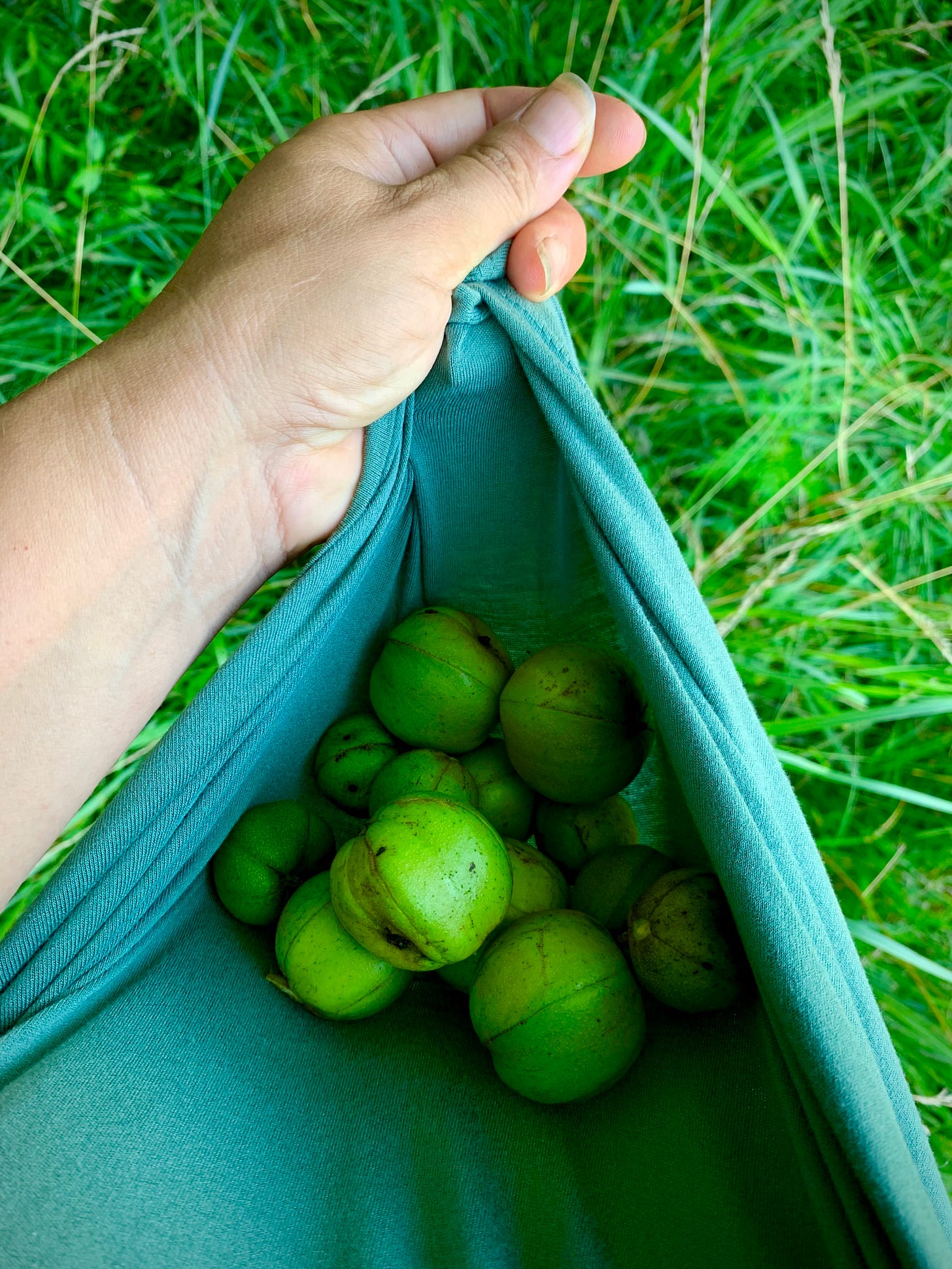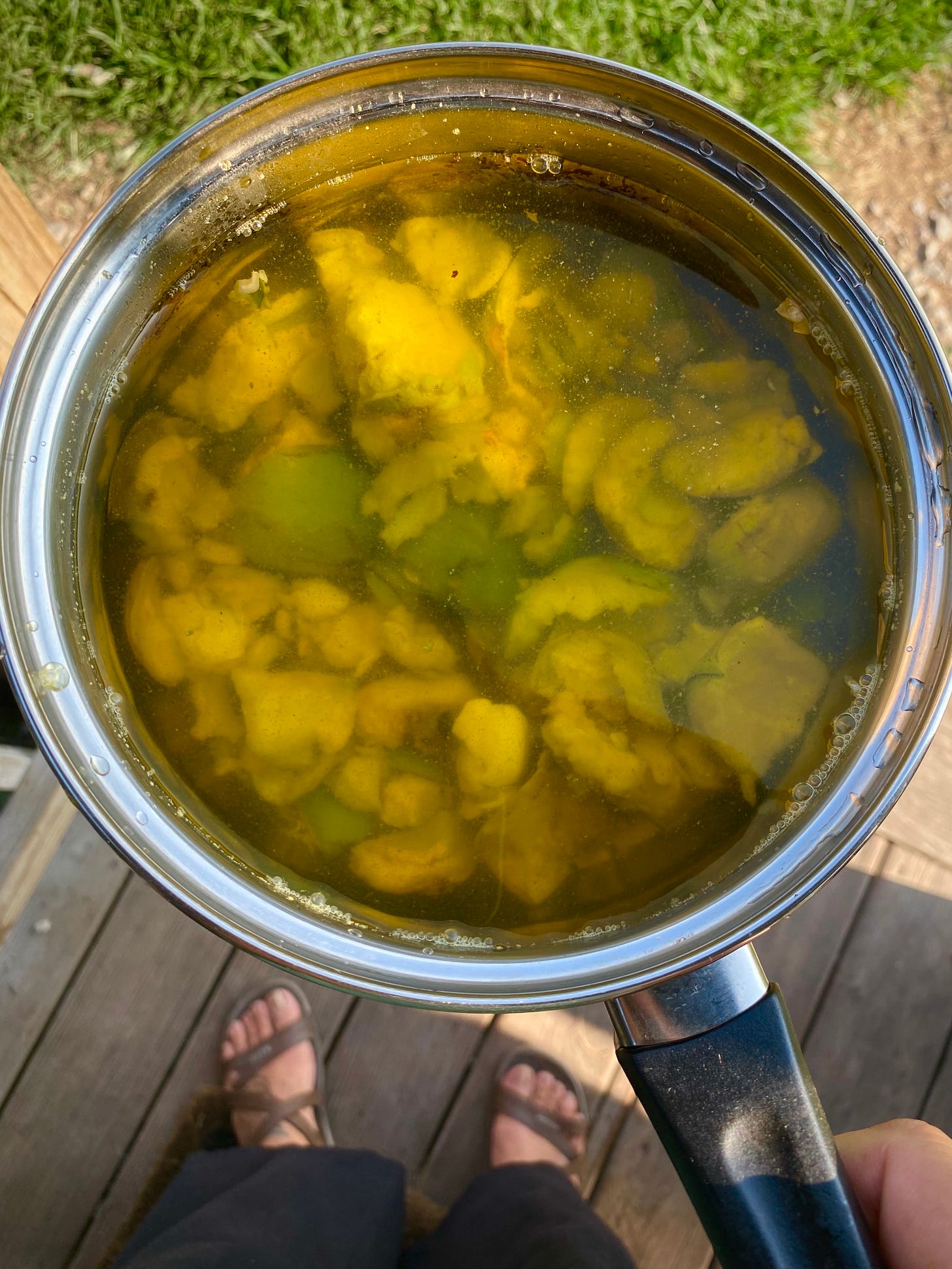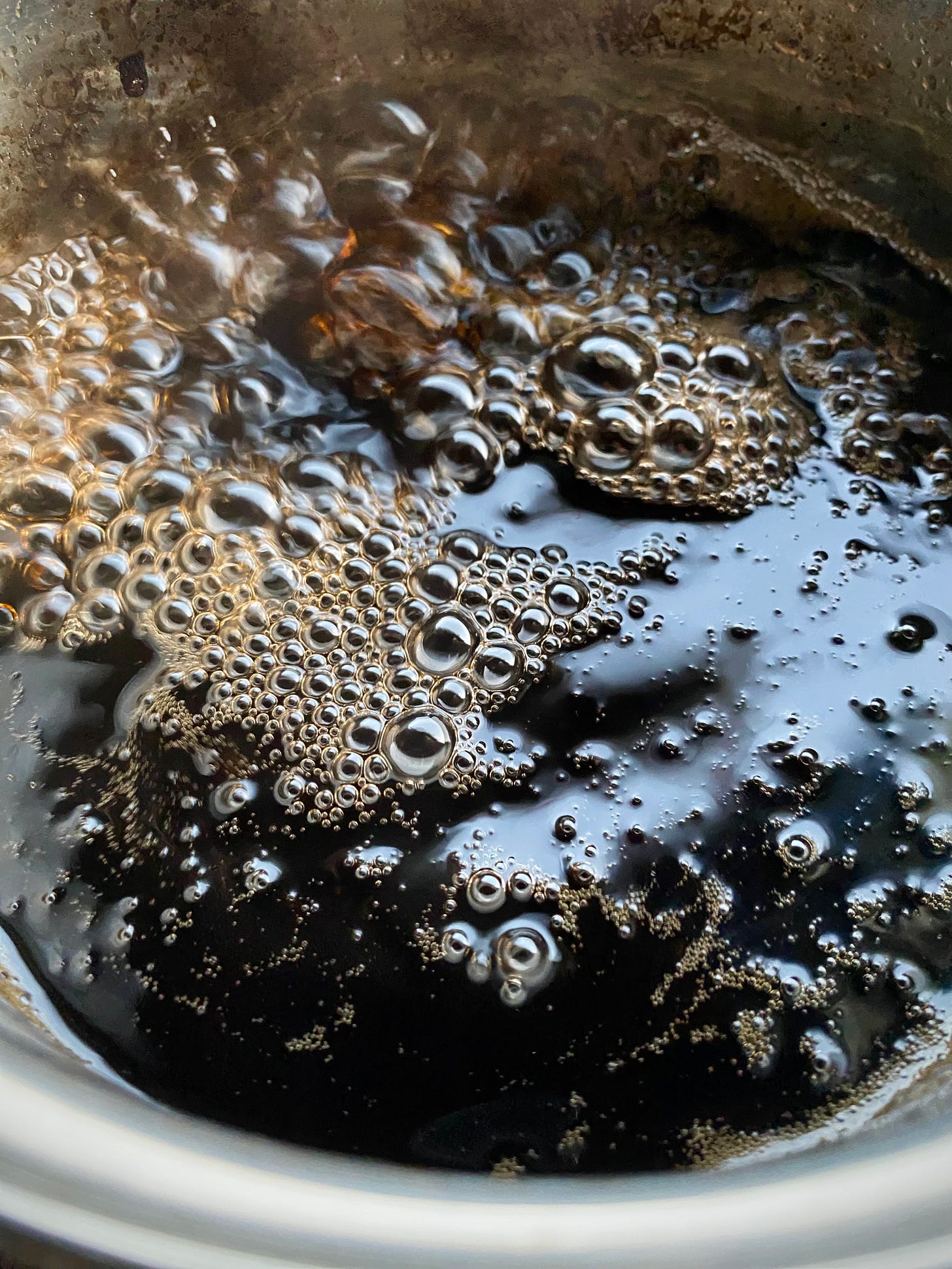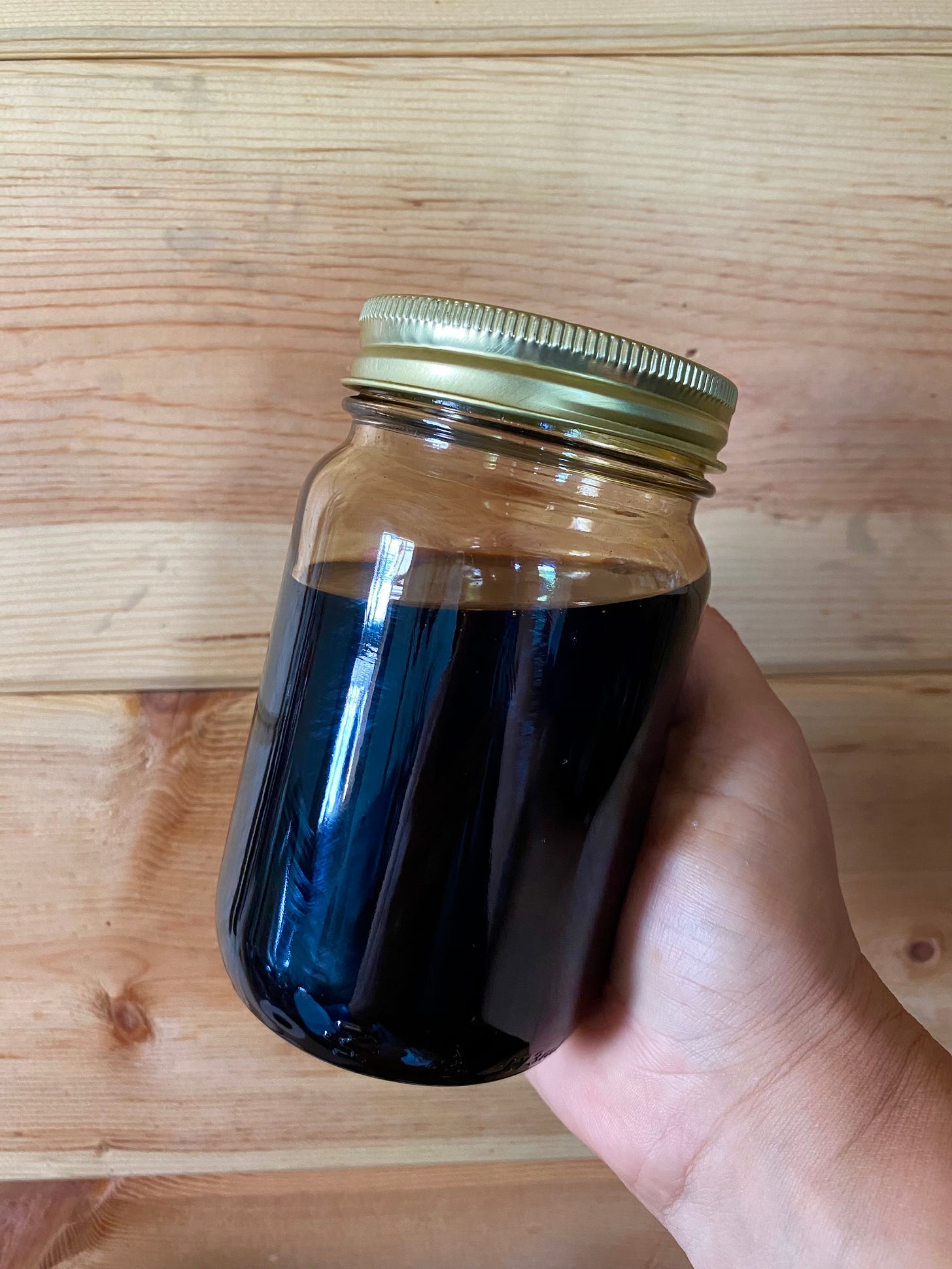Foraging Wild Foods: A Folk Recipe for Green Hulled Shagbark Hickory Nut Syrup
I saw him from the window, running back to the cabin from playing in the woods, holding the bottom of his shirt up and close, protecting his precious harvest.
“Momma, there are so many hickory nuts on the trees right now! Here, I brought you some. Will you make me syrup?”
He’s 6.
And while we routinely craft Shagbark Hickory Syrup (from the bark of the hickories) for the FarmStore, and we usually make Hickory Milk once a year in the Autumn, we’ve never made syrup from the green hulled nuts.
But the boy just knows.
He and I looked thru the search engines, forums, and apps together to see if we could find a tried and true recipe. Nothing that we could find spoke directly to the crafting of syrup using the fresh & green hickory nuts.
So we decided instead to use our critical thinking skills by calling upon what we know: that folks do make syrup from other like green hulled nuts ie black walnuts; that no hickory nut is poisonous (not all are necessarily palatable, but they are all non-toxic); we know the principles, and have a deep understanding of the method, of herbal syrup crafting; and we know, because we’ve read books about how the native peoples and early settlers to this local area often used the entire hickory nut (shell/hull and all) for nut milk, syrups, and porridges. Especially using species like Shagbark, that are what predominately stand to offer us the woodlands here on Farm.
Putting it all together, we got to work.
And let me tell you,
what we crafted,
wow, just wow!
It’s a deeply nourishing, highly medicinal, super grounding, earthy, connected culinary masterpiece!
Not only did we find a way to make something new (to us).
We established tradition.
Core memories, for both of us.
The Gifts of Fresh Green Hulled Shagbark Hickory Nut
As I mentioned, Shagbark Hickory (Carya ovata) is best known for its sweet, smoky bark syrup and tasty & unique nut meat.
However, when green, still on the tree, and used whole (hull, shell, and immature meat) this form of the medicine, along with it’s culinary use, is rarely written about. All the while it offers powerful actions not found later in the year, when the nut matures.
When gathered at the right time, the green hulled hickory nut becomes a potent digestive tonic, mineral supplement, and multiple systems protector.
Learning and remembering all of this information, I found it of value for myself to create a materia medica entry for inclusion in my personal collection that honors the green nut during this brief, peak harvest window, when the shell is still soft enough to crack and the hull is rich with bitter, medicinal resin.
And it’s a joy to share it with you here.
Materia Medica
Common Name: Shagbark Hickory Nut (Green Hulled)
Botanical Name: Carya ovata
Family: Juglandaceae (Walnut family)
Parts Used: whole immature nut; green hull, developing shell, and unformed nut meat
Harvest Window: early-mid summer (July in Zone 6), while still on the tree, before the outer hull dries and the inner shell hardens
—Active Constituents: Tannins (astringent, gut-toning, antimicrobial): Juglone (trace amounts; antifungal, antiparasitic): Essential Fatty Acids (oleic and linoleic acid): Sterols & Phenolic Compounds (antioxidant, anti-inflammatory); Volatile resins (mildly stimulating, aromatic)
—Mineral Content: Magnesium (nervous system, muscle tone); Potassium (heart & electrolyte balance); Zinc (immunity & hormone regulation); Manganese (antioxidant); Calcium and Phosphorus (bone & cellular structure)
—Herbal Actions: astringent (tones mucosal tissues of the gut, mouth, skin), digestive bitter (support bile production & liver function), antimicrobial, nervine tonic (very grounding in this way), nutritive (restorative after mineral depletion), mild anthelmintic (helps expel internal parasites), warming tonic
—Medicinal & Therapeutic Benefits:
helpful in the case of digestive sluggishness and poor bile flow
it’s astringent action helps to tone and alleviate mild diarrhea or leaky gut
in the case of nervous exhaustion and depletion [the syrup especially] support nervous system restoration
juglone and the resinous compounds support immune modulation in cases of fungal or bacterial imbalance
a parasite cleanser, especially effective when paired with other traditional anthelmintics (like black walnuts, wormwood, and cloves)
a powerful terrain rebuilder post-illness an/or during seasonal shifts
—Energetics:
Temperature: Warming
Moisture: Drying
Primary tissue states: Relaxation, dampness, decreased muscle tone
—Doctrine of Signatures: The Doctrine of Signatures, for those unknowing, is the ancient belief that a plant’s physical characteristics (ie shape, color, or texture) tells us its intended healing purpose and speaks to the bodily systems it supports. In this case, the soft green hull of the hickory nut would represent its layered protection. The nut is essentially shielded by its bitter resin and shell, just as this medicine protects and strengthens the inner terrain of the body. The whole nut signifies protection, containment, discernment, and the power of store potential. It is a medicine for preparing the body and spirit for hardship before it arrives. A beautiful midsummer offering. A beautiful gift for our times.
—Preparations: Green hulled hickory nuts can be used to craft: syrup, cordials, decoction (for parasite cleansing tonics/blends), infused into apple cider vinegar, and the syrup paired with black walnut hull/wormwood tincture to make an parasite cleansing elixir
—Harvesting & Processing Notes:
Harvest while the outer hull is green and soft; still on the tree; the inner shell should still be breakable
Crack or crush gently before simmering to expose the nut and internal plant material
Simmer gently in water for 1–2 hours to extract flavor and nutritive/medicinal compounds
Press and strain thoroughly; reduce liquid as needed before sweetening
—Cautions: high tannin content may be overly drying for those with dry constitutions; large internal doses not recommended during pregnancy; take in small/moderate amounts due to bitter compounds
The Art of Herbal Syrup Making
Herbal syrup making is an old kitchen craft that deserves revival.
Part medicine making, part prayer.
It invites you to slow down, listen, and cast intention.
You’re not just reducing a liquid,
you’re concentrating the energetic essence of a living plant for nourishment and healing.
When making syrup, you always want to simmer your decoction gently.
Never boil it hard, as such a high heat can have a negative effect on volatile compounds and ruin the flavor. We want a soft, rolling simmer (around 180–200°F to get technical).
You’ll know it’s done when the liquid thickens just enough to coat the back of a spoon and drip slowly, like honey.
It will continue to thicken as it cools.
There’s no rush here.
Green Hulled Hickory Nut Syrup: Folk Recipe
Ingredients:
2 parts green hulled hickory nuts (cracked, not fully shelled)
4 parts fresh water
1 part organic cane sugar
Method:
Rinse your green hickory nuts with fresh water. We used a meat tenderizer (a hammer would suit too) to lightly crack the nuts, just enough to break the shell and expose the inner parts. You want to use the whole nut, green hull and all.
Add the nuts (2 parts) to a pot and cover them with clean water (4 parts). Bring to a simmer and simmer low and slow for about 1 to 2 hours. This is where I let the heavenly smell of smoky, earthy hickory be my guide. Likewise, you will see that the decoction will darken and become rich in color.
Strain through a cheesecloth and press to extract the liquid and discard the solids. Return the strained liquid to a clean pot and simmer again to reduce by about by half.
Once reduced, measure the liquid and add an equal amount of sugar. It needs to be a 1:1 ratio by volume. Tip: For longer shelf life, especially if you’re looking for a shelf-stable syrup (storing not in the fridge), use 1 part liquid to 1.5 parts sugar. Stir over low heat just until the sugar dissolves. Avoid stirring too much as this prevents crystallization of the syrup later in storage. Instead, occasionally swirl the pot in a circular motion to distribute the heat and dissolve the sugar evenly. Tip: In syrup making folklore, stirring clockwise invokes structure, preservation, and order (perfect for a syrup meant to keep); stirring counter-clockwise works in opposition & invites release, dispersion, and transmutation (best suited for medicine intended for short-term use or with the intention of release)
Jar the syrup warm. Keep stored as according to your method of preparation and sugar content.
We are enjoying this seasonal syrup in our coffee and herbal teas,
drizzled atop ice cream, yogurt, and fresh berries,
and of course my boy is loving it on his sourdough waffles.
I hope if you have access to Shagbark Hickories, you are inspired to join us in this tradition of seasonal connection, medicine making, and foraging wild foods!
Let me know if you have any questions in the comments. I’m happy to help clarify and support.
—Andrea
Our Off Grid Life









